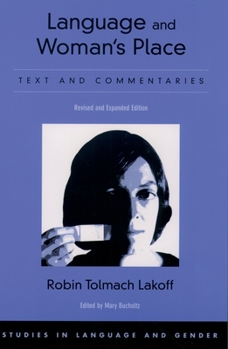Language and Woman's Place: Text and Commentaries
Select Format
Select Condition 
Book Overview
The 1975 publication of Robin Tolmach Lakoff's Language and Woman's Place, is widely recognized as having inaugurated feminist research on the relationship between language and gender, touching off a remarkable response among language scholars, feminists, and general readers. For the past thirty years, scholars of language and gender have been debating and developing Lakoff's initial observations. Arguing that language is fundamental to gender inequality, Lakoff pointed to two areas in which inequalities can be found: Language used about women, such as the asymmetries between seemingly parallel terms like master and mistress, and language used by women, which places women in a double bind between being appropriately feminine and being fully human. Lakoff's central argument that "women's language" expresses powerlessness triggered a controversy that continues to this day. The revised and expanded edition presents the full text of the original first edition, along with an introduction and annotations by Lakoff in which she reflects on the text a quarter century later and expands on some of the most widely discussed issues it raises. The volume also brings together commentaries from twenty-six leading scholars of language, gender, and sexuality, within linguistics, anthropology, modern languages, education, information sciences, and other disciplines. The commentaries discuss the book's contribution to feminist research on language and explore its ongoing relevance for scholarship in the field. This new edition of Language and Woman's Place not only makes available once again the pioneering text of feminist linguistics; just as important, it places the text in the context of contemporary feminist and gender theory for a new generation of readers.
Format:Paperback
Language:English
ISBN:0195167570
ISBN13:9780195167573
Release Date:July 2004
Publisher:Oxford University Press, USA
Length:328 Pages
Weight:1.05 lbs.
Dimensions:0.7" x 6.4" x 9.2"
Customer Reviews
2 ratings
A Classic in its time
Published by Thriftbooks.com User , 16 years ago
During the late 1970's and early 1980's I bought dozens of copies of this book for everyone I knew. This was in the days before politically correct language, and the work environment was demeaning to many women. My favorite line is the book was about how women avoid rough language, and how inappropriate that avoidance is. "Oh, fudge, your hair is on fire." is one of the examples that I remember 30 years later. This is great reading and can give a real sense of what that timeframe in history was like. It's been recognized as a classic. You'll even find it in Wikipedia.
open to criticism, but still a classic
Published by Thriftbooks.com User , 22 years ago
It has been almost 3 decades since the publication of Language and Woman's Place. Though it was a 'pioneering' work at the time of its publication, there has been a stream of research in the language and gender area since then, and now it has become a 'classic'. Being a classic doesn't mean that it is immune from criticism, though. One thing that stands out to today's readers is that it is almost 'sexist' in "measuring women's language against men's", that is taking male language as 'norm' and viewing woman's as a "deviation" from it. It was in this "male-as-norm" tradition of research, for instance, that she could speculate that women use more tag questions than men because they learn the lesson not to be as assertive as they are. However, the book is a delightful read for anyone interested in the issue of language and its relationship to sexual oppression. It is very readable and anticipates such subsequent studies as Dale Spender's Man Made Language in many ways.






